Last of the Pagans (1935)
“Perhaps the best way to approach films such as The Last of the Pagans and Omoo Omoo the Shark God is to see them as exemplifying a marketing strategy which reduces the author’s name to the function of signifying ‘literature’ as part of the total entertainment package offered by these films.” — Hayes, Kevin J. Herman Melville in Context. Cambridge UP, 2018.
Last of the Pagans (1935) was, supposedly, an adaptation of Herman Melville’s first novel Typee (1846). The film was only the fourth adaptation for the screen of Melville. It was preceded by The Sea Beast (1926), a silent adaptation of Moby-Dick starring John Barrymore; Moby Dick (1930), a sound remake of The Sea Beast again starring Barrymore and a German-language version filmed simultaneously with it but starring William Dieterle, Dämon des Meeres (1931).
The “Melville revival” of the 1920s likely contributed to the cinematic interest in Melville of the 1920s and 30s, or, as Hayes wrote, at least some recognition within the film industry that Melville’s name potentially had some value as a marketing tool.
LOS ANGELES, Oct. 25.—[…]
When Phil [Goldstone], who incidentally makes mighty good pictures and who will be one of the producers at MGM, finishes Verne’s epic, he will concentrate on “Topee,” [sic] a short story by Herman Melville, author of “Moby Dick.” He will put Mala, hero of “Eskimo,” who has as much S. A. as Clark Gable and Lotus Long, an Oriental whiz, (confidentially she’s Anna May Wong’s sister) into what he calls a “Marquesan Romance.”
Parsons, Louella O. “Miss Lombard Selected for Krasna Opera.” Albany Times-Union. October 25, 1934: 24 col 1.
TYPEE, original, purchased by Metro, and to be produced by Phil Goldstone with Mala, the Eskimo, in the lead.
“Story Sales.” Motion Picture Herald 117(6). November 10, 1934. 25.
Snapshots of Hollywood collected at random—[…] Mala refusing a double for his underseas scenes in “Typee;” he’ll do them himself for Phil Goldstone
New Orleans States. November 26, 1934: 6 cols 6-7.
“Typee,” Herman Melville’s charming story of the South Sea Isles, will be made with approximately only 200 words of English dialogue. Meaning that you and I shall have to content ourselves with a few native Polynesian phrases and such lovely camera and sound effects as may make us forget the lack of words.
Eskimo was made under conditions similar to this, and Francis Lederer’s first American film, “Man of Two Worlds,” served to introduce this popular actor to our audiences, although the entire story gave him scant opportunity to speak more than a few words at a time.
If “Typee,” as it appears in the films, scores half the hit that the novel did, we are in for a treat indeed.
Merrick, Mollie. New Orleans Item. January 23, 1935: 12 col 6.
Two productions to be supervised by Phil Goldstone, who recently signed a long-term contract with Metro-Goldwyn-Mayer, are announced by the film company. One of these will be Herman Melville’s “Typee,” in which Mala, the Eskimo lad who had the male lead in “Eskimo,” will be featured. The other is “Coast Patrol,” an original story by Dorell McGowan and Stuard Edward McGowan, an adventure drama with a background of the United States Coast Guards.
“Production News From the M-G-M Lot.” Cairns Post [Queensland, Australia]. February 28, 1935: 8 col 5.
What is claimed to be the largest motion picture expedition in film history departed recently for the South Seas. Two pictures are planned, “Typee,” from Herman Melville’s book of that name, and “Mutiny on the Bounty,” from the first volume of the Bounty trilogy by Nordhoff and Hall. Frank Lloyd, director of the Bounty picture, will set up his headquarters at Papeete, where two Tahitian villages will be constructed by native labor to duplicate those in existence 150 years ago.
“In a World of Books.” Kansas City Star. April 6, 1935: 14 col 5.
“Last of the Pagans” is announced by Metro-Goldwyn-Mayer as final title for the picture based on Herman Melville’s novel, “Typee.” The picture, now nearing completion at the Culver City, was formerly known as “Mala.” The leading roles are played by Mala, star of “Eskimo,” and Lotus Long. Richard Thorpe is the director.
Oregonian. October 20, 1935: 39 col 7.
Herman Melville’s novel “Typee,” will reach the screen via M-G-M, under the title “Last of the Pagans,” and will have Mala, star of “Eskimo” and Lotus Long in the leads.
“Studios Show Busiest Slate of Productions.” San Diego Union. November 10, 1935: 29 col 2.
When Phil Goldstone (the producer) left M-G-M he left ’em with a kind of a problem on their hands. First of all, there were thousands and thousands of feet of the South Sea island picture, “Typee,” featuring Mala, left uncut and unassembled which naturally made it rather difficult for those unacquainted with the production to get it together sensibly for public consumption.
Pantages, Lloyd. “Half Million Set Aside for Work Projects Films.” Detroit Times. December 15, 1935: 42.
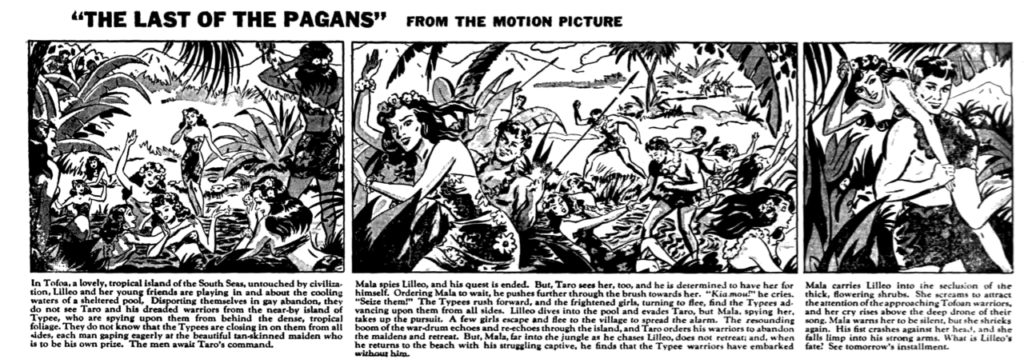
“‘The Last of the Pagans’ from the motion picture.” Erie County Independent [Hamburg, NY]. December 26, 1935: 7. [Cropped and edited from scan by Fultonhistory.com]

“‘Last of the Pagans’—From the Motion Picture Coming Soon to the IDEAL THEATRE.” Tribune [Philippines]. May 12, 1938: 9. [Cropped from scan by National Library of Australia’s Trove.]
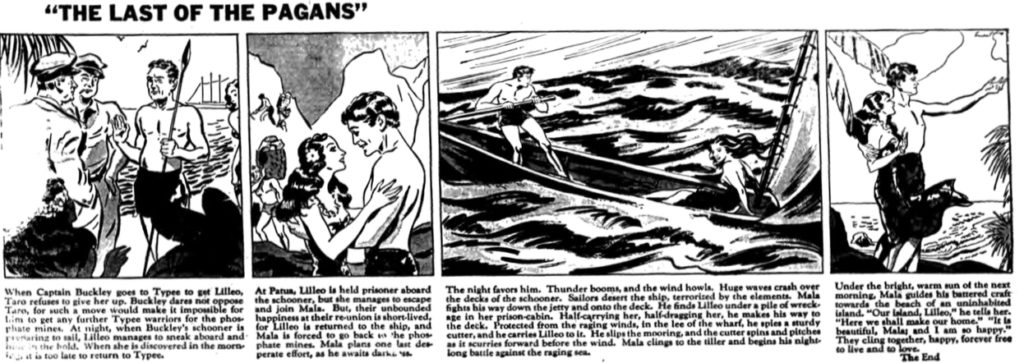
Erie County Independent [Hamburg, NY]. February 13, 1936: 7. [Cropped and altered from scan by Fultonhistory.com]
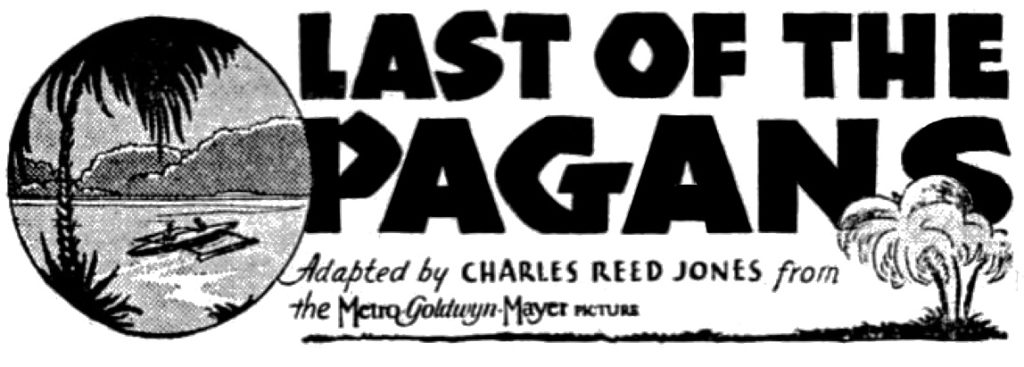
Bradford Evening Star [PA]. January 15, 1936: 7. (Header from serialized fictionization of the film)
STANTON—”Last of the Pagans.”
a romance of the South Seas, featuring Mala and Lotus Long, will replace “Riffraff,” with Jean Harlow, Spencer Tracy and Joseph Calleia, at this house Wednesday. Filmed on an uncharted coral island, where the native life is untouched by civilization, “Last of the Pagans” is based on “Typee,” a novel by Herman Melville, which deals with a boy and girl separated through the trickery of white traders and reunited through the bravery of the native warrior. The cast supporting Mala, the Eskimo actor, and Miss Long is entirely native. Clyde De Vinna was the cameraman and Richard Thorpe the director.
Philadelphia Inquirer. January 12, 1936: 10 col 3.
SOUTH SEA girls are more romantic than many of Hollywood’s charmers because they never hide their emotions and they don’t try to vamp!
So declares Mala, Esskimo actor, and hero of “Last of the Pagans,” Metro-Goldwyn-Mayer’s romance of life in the Marquesas Islands, filmed in a five months’ trip to the South Seas, coming to the Stanton on Tuesday.
The hero of “Eskimo” and Lotus Long were the only two Hollywood players. The rest of the cast was made up of natives of an atoll in the group, and a few sailors cast in other roles. Richard Thorpe directed the picture.
“There is something refreshing and romantic about the girls there,” relates Mala. “In the first place, they are absolutely honest. If a girl likes a man, she lets him know it without concealing her emotions. They don’t flirt. They don’t try to vamp a man they like. They simply let him know about it and if he likes the girl who likes him that’s that.
“You never see a native girl pretend to like a man if she doesn’t, as you sometimes see in Hollywood. You don’t see any of the vamping you see here. For a girl to make herself up, to be more attractive to a man is unheard of there. And the men don’t talk big and pretend to be big shots to impress the women either. Everybody takes everybody else as he or she comes.”
Mala hastens to add that he didn’t have any affairs of the heart with native girls while there. He insists that his remarks are based on observation only.
“Some of the native girls are very pretty,” adds Mala, “but they age rapidly. All of them are learning to wear modern clothes, especially in the towns, and cut their calico to resemble pictures they see in American, English and French magazines. Girls used to come to me with dresses they’d made, and ask if they looked like what Joan Crawford was wearing—or Jean Harlow, or Claudette Colbert. But they don’t do this with any idea of appealing to the sterner sex. That’s the remarkable thing about them.”
Philadelphia Inquirer. January 22, 1936: 11 cols 6-7.
“FREE from Hollywoodism” is the comment on the picture “Last of the Pagans” which is winning notice from the type of film-fan who liked “Shadows of the South Seas,” “Tabu,” and similar pictures. “Last of the Pagans” has an original story written and adapted to the screen by John Farrow whose brochure “Origin of the Polynesians” won him a fellowship in the Royal Geographical Society.
With a background of South Sea Island scenes against which is unfolded a romance of two natives played by Ray Wise and Lotus Long, “Last of the Pagans” is unusual in that much of its dialog is in Polynesian. Titles and a musical score aid in interpreting the story and the picture is said to have recaptured the imaginative fascination of the silent films by use of this technic.
Croughton, Amy. “Scanning the Silver Screen.” Malone Morning Telegram [NY]. February 13, 1936: 7 col 8.
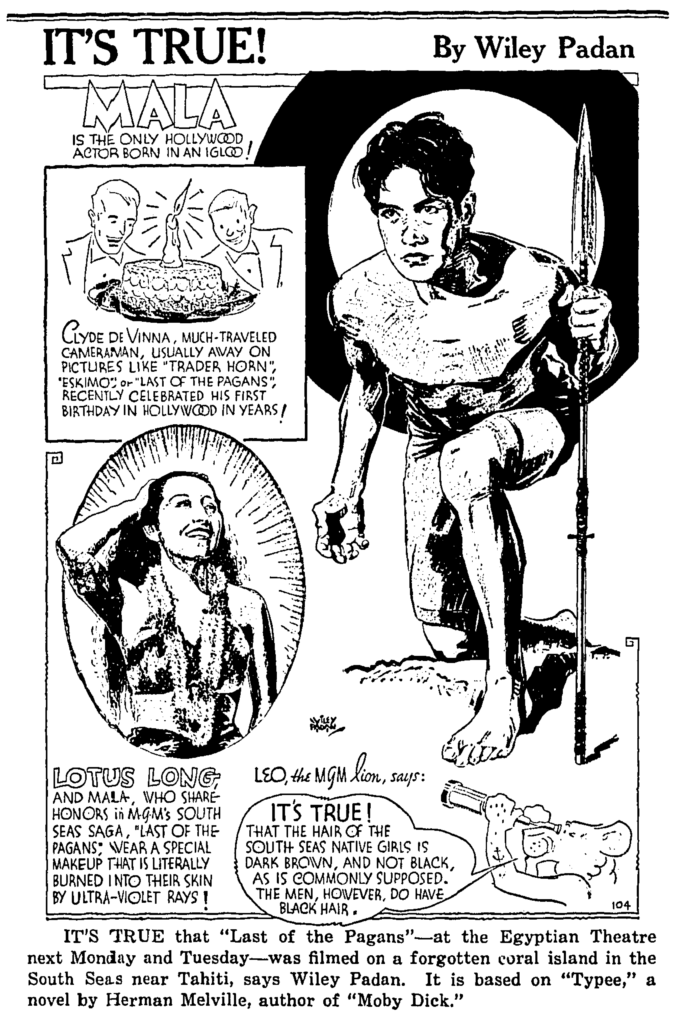
“IT’S TRUE that ‘Last of the Pagans’—at the Egyptian Theatre next Monday and Tuesday—was filmed on a forgotten coral island in the South Seas near Tahiti, says Wiley Padan. It is based on ‘Typee,’ a novel by Herman Melville, author of ‘Moby Dick.'”
Padan, Wiley. “It’s True!” Our Town [Narberth, PA]. March 13, 1936: 2 cols 2-3. [Syndicated item.]
Heavy Bookings To Scene Of Mutiny On the Bounty
Shipping companies this year can thank Hollywood. According to report from the United States, the release of the film “Mutiny on the Bounty,” “The Last of the Pagans” “China Seas,” “Oil for the Lamps of China,” and “Shanghai” have resulted in steadily increased reservations to Tahiti, French Oceania, and China, especially the first two listed.
Since the release of “Mutiny on the Bounty,” a San Francisco official said, “inquiries on travel to Tahiti have jumped 50 per cent.”
Malaya Tribune [Singapore]. March 28, 1936: 2 col 3.
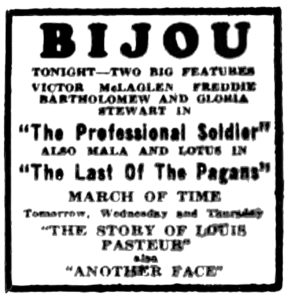
Times Record. April 20, 1936: 15 col 8.

Tribune [Philippines]. May 13, 1936: 8. [Cropped from scan by National Library of Australia’s Trove.]
168 FEATURES LISTED FOR THEATRE TIEUPS IN “NATIONAL BOOK WEEK”
The attention of motion picture theatre owners again is directed, for the 15th year, to “National Book Week,” now underway. In this connection the National Board of Review has made available for use in arranging programs that lend themselves to book tieups, an annual compilation of “Selected Book-Films,” prepared in conjunction with the “Book Week” movement that is sponsored by the National Association of Book Publishers. […]
Films Adapted from Novels […]
LAST OF THE PAGANS, THE (“Typee” by Herman Melville). Metro-Goldwyn-Mayer.
Motion Picture Herald 125(8). November 21, 1936. 77.
20,000 EDUCATORS DISCUSS FILMS; PICTURE PLANS FOR NEW YORK FAIR
Section of NEA’s Convention Program Allotted to Screen Topic, “Learning Through Seeing,” with Students’ Discussion
Use of motion pictures in educational work was one of the chief topics this week when 20,000 educators gathered in New York City for the 76th annual convention of the National Education Association. […]
In the coming year, starting July 1st, the commission expects to prepare 40 more films for classroom presentation. The pictures are obtained through an arrangement with Paramount, Metro-Goldwyn-Mayer, Warner Brothers, Twentieth Century-Fox, March of Time, Fox Movietone News and French Motion Picture Corporation. One year after general release, those sections deemed to have education value in human relations are edited “to bring out the social implications clearly and forcefully.” […]
The features from which these short subjects already completed were made and the points brought out are as follows:
Metro-Goldwyn-Mayer […]
LAST OF THE PAGANS, native ceremonies.
LAST OF THE PAGANS, conscripted labor.
Motion Picture Herald 132(1). July 2, 1938. 31.
Several years ago—seven to be exact—Director Richard Thorpe made a location trip to the South Sea Islands for a M-G-M picture, “The Last of the Pagans.” Dick is an avid amateur photographer, and the still pictures he took of Tahitian shore lines, beaches and harbors attracted no little attention when they were later exhibited around the country. But never in his wildest moments did he think those pictures would become important to official Washington until the other day when the War Office wrote him asking for a complete set of his art studies for use by military strategists. “I am prouder that my set of stills is of service to Uncle Sam,” says Thorpe, “than of any movie I ever produced.”
Syracuse Herald-Journal. July 24, 1942: 24 cols 6-7.
“Last of the Pagans.” Turner Classic Movies. http://www.tcm.com/tcmdb/title/80899/Last-of-the-Pagans/ [Includes film trailer]
Ketelbey, Albert W. “By the Blue Hawaiian Waters.” http://www.albertketelbey.org.uk/discs/data/by%20the%20blue.htm http://bdh.bne.es/bnesearch/detalle/2780578
[Song that featured in the film. Hawaiian music such as “By the Blue Hawaiian Waters” became popular in the 1920s – coincidentally the decade of the “Melville revival.”]
See also Robert J. Flaherty and Typee; F. W. Murnau and Typee; John Huston and Typee; Enchanted Island (1958)